- Text & photos: Natalia Melikova
[This essay was written for La città d’acciaio. Mosca costruttivista 1917-1937. This is the first time the essay is being published in its original English.]
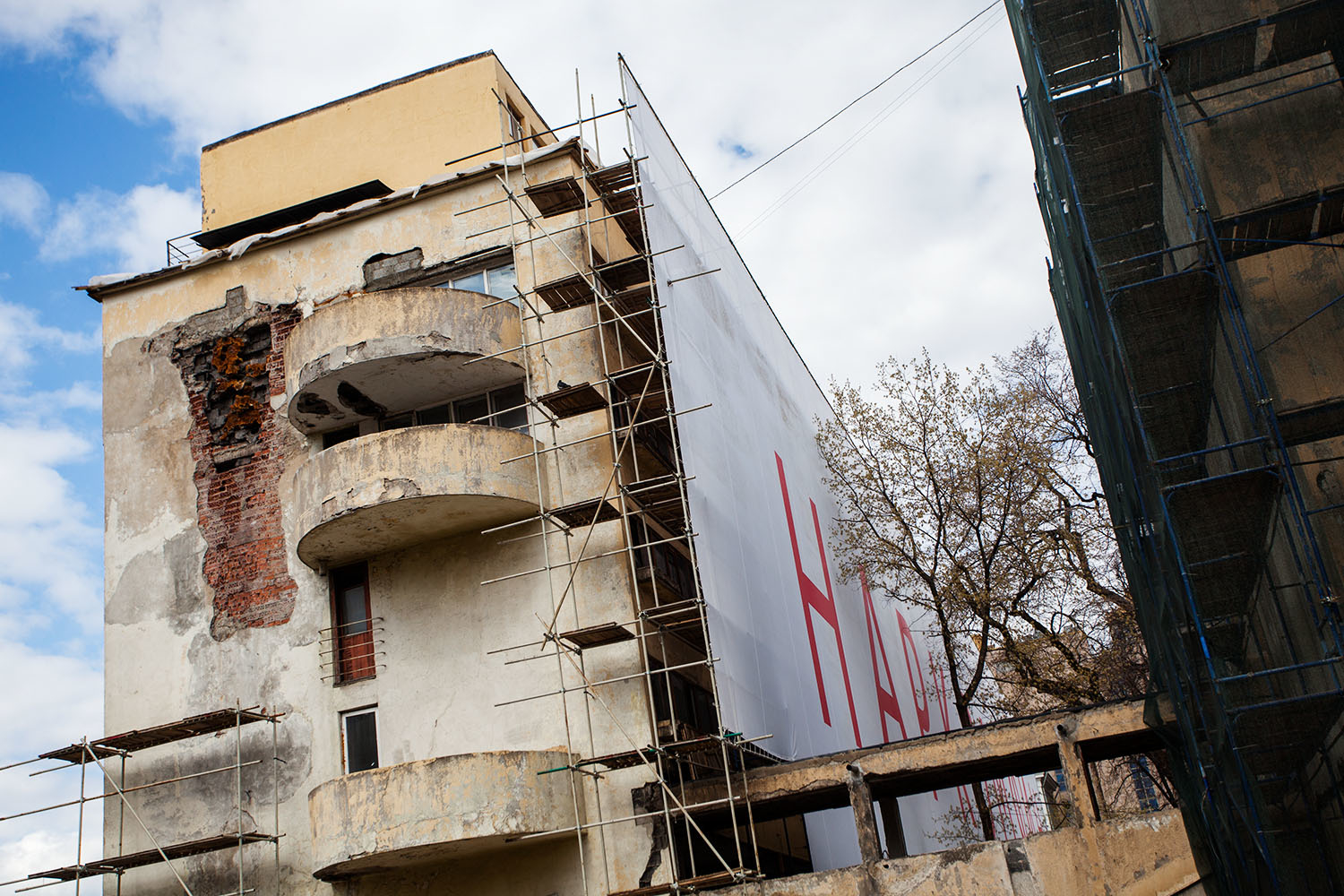
The Narkomfin building, covered in scaffolding and a huge banner reading НАРКОМФИН, in the process of restoration (2017 - 2019) | April 2018
Moscow — “the city where history is made”1 — celebrated its 870th anniversary decked out in the style of constructivism and the avant-garde of the 1920s. “We would like to show Moscow's contribution to international design, and therefore constructivism was chosen as the most characteristic architectural and cultural style for our city,”2 announced Alexander Kibovskiy, head of the Department of Culture, and former head of the Department of Cultural Heritage, adding that it is precisely the Russian avant-garde that all around the world is considered to be an absolutely original style and a significant innovation in the art world3. The red, white, and blue geometric graphics, now called the Moscow Pattern, directly cites textile designs by Lyubov Popova and Varvara Stepanova from the early 1920s, and served as the official branding for the 2017 City Day festivities in September. Dynamic, eye-catching and still fresh, the retro-constructivist graphic design was used to promote and celebrate achievements tied to Moscow’s history. One of the seven themes of accomplishments, “Moscow Builds,” championed the capital’s rich and diverse architectural heritage.
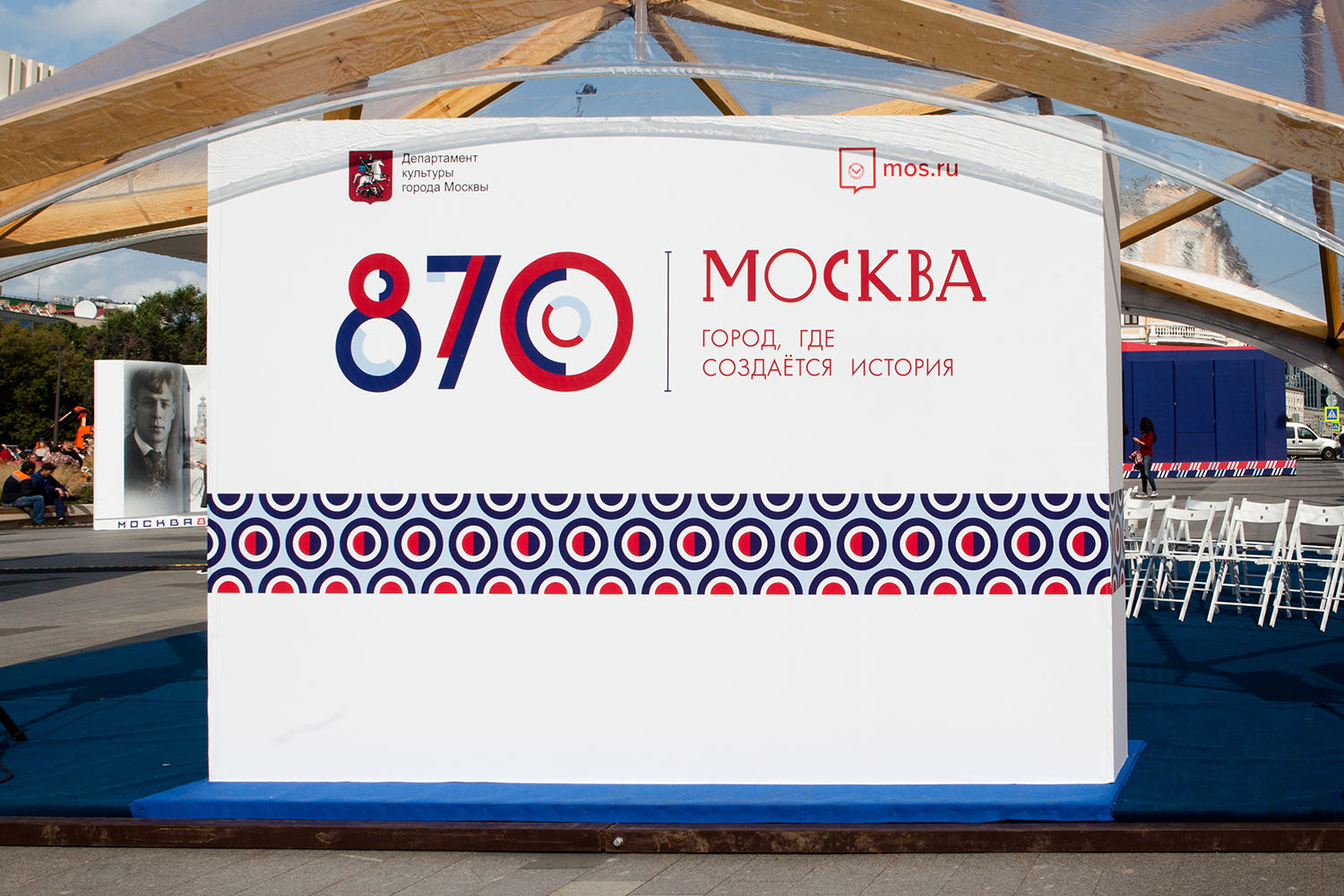
Moscow — “the city where history is made” | September 2017
This City Day publicity and branding campaign is confirmation that on an official level, the avant-garde is recognized as a significant movement. This is not a singular instance as Russia has shown off its avant-garde legacy on the global stage during recent Olympic Games. Several minutes during the 2014 winter games opening ceremony in Sochi were dedicated to the avant-garde. In 2016, the Russian team at the summer games in Rio sported avant-garde inspired uniforms (fashioned after Alexander Rodchenko’s posters and Varvara Stepanova’s designs). The new uniforms were presented at the State Tretyakov Gallery in front of a hall featuring a recreation of the 1921 OBMOKhU exhibition, the early experiments of the Constructivists on full display at this important PR event for the Olympic team. "The Russian avant-garde is one of the most famous and vivid pages in the history of Russian art," noted Alexander Zhukov, president of the Russian Olympic Committee. "But the main thing is that this is the avant-garde, and therefore, in such a uniform it’s impossible to be behind, you can only be ahead, be leaders.”4 In the Olympic context, the avant-garde conveyed the notion of being at the forefront — after all, coming in first place is important for sports competitions. One of the Olympic athletes praised the aesthetics of the design, as well as its emphasis that it is the national style: "It is very different from others, it's very recognizable. And most importantly, it's clear that it’s Russian, it’s ours."5 From such enthusiasm for the avant-garde — its aesthetics, its significance and continuing relevance — one could draw the conclusion that in Russian society, the avant-garde is well-received. Unfortunately, as reality shows, while the avant-garde art brand is readily exploited, avant-garde architecture does not enjoy the same popularity.
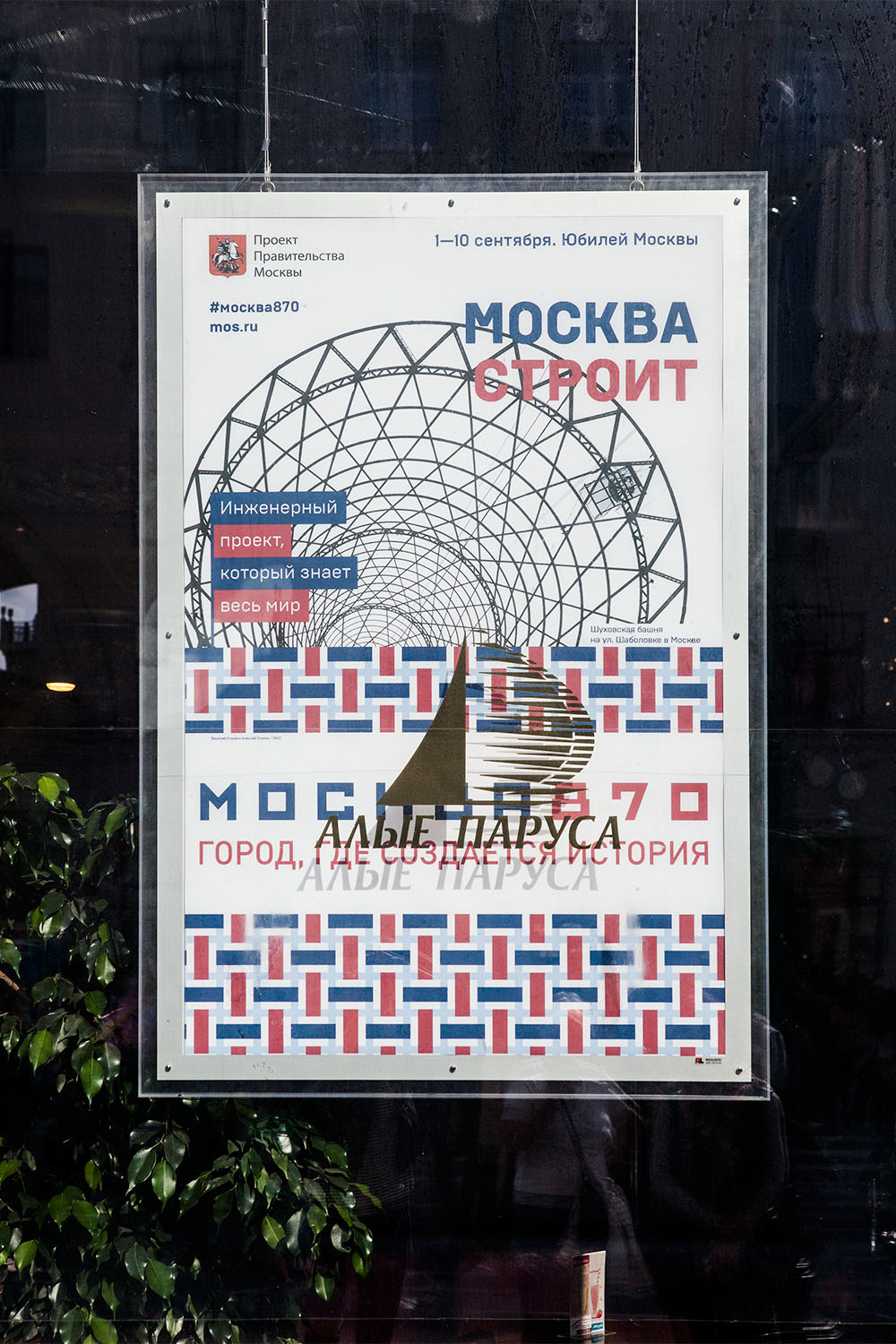
"An engineering project known all over the world." | September 2017
During the City Day celebrations, one of the posters seen all around Moscow featured the Shukhov Tower, with the proud words “An engineering project known all over the world.”6 Just three years ago, the tower was threatened with demolition sparking a massive local and international campaign demanding its protection and preservation. For over thirty years, the tower has not — at minimum — been treated for corrosion. This year the tower celebrated its 95th anniversary having not once undergone a comprehensive restoration. Though demolition of “the Eiffel Tower of the East,” as the tower was nicknamed during the campaign to save it, was cancelled, this victory was short-lived. The tower continues to corrode and is now resting on an internal support structure built in 2016 as an emergency measure to stabilize the tower, with some experts concerned that this structure may in fact damage it. A symbol of Russian television and radio, and revered around the world for its engineering ingenuity and beauty, it is by all accounts ignored at home by the authorities. Future plans for the tower are unclear, and a sense of urgency to finally carry out a much overdue restoration is lacking. The Russian Shukhov Tower Foundation headed by the great-grandson of the famed engineer Vladimir Shukhov, along with local and foreign specialists in metal structures are ready and willing to participate, but are shut out of the process deciding the fate of the tower. Yet the tower makes every list as an iconic monument of architecture. During the City Day celebrations, a replica of the Shukhov Tower decorated Tverskaya Street as an “art object,”7 while the real tower continues to rust away in the Shabolovka district.
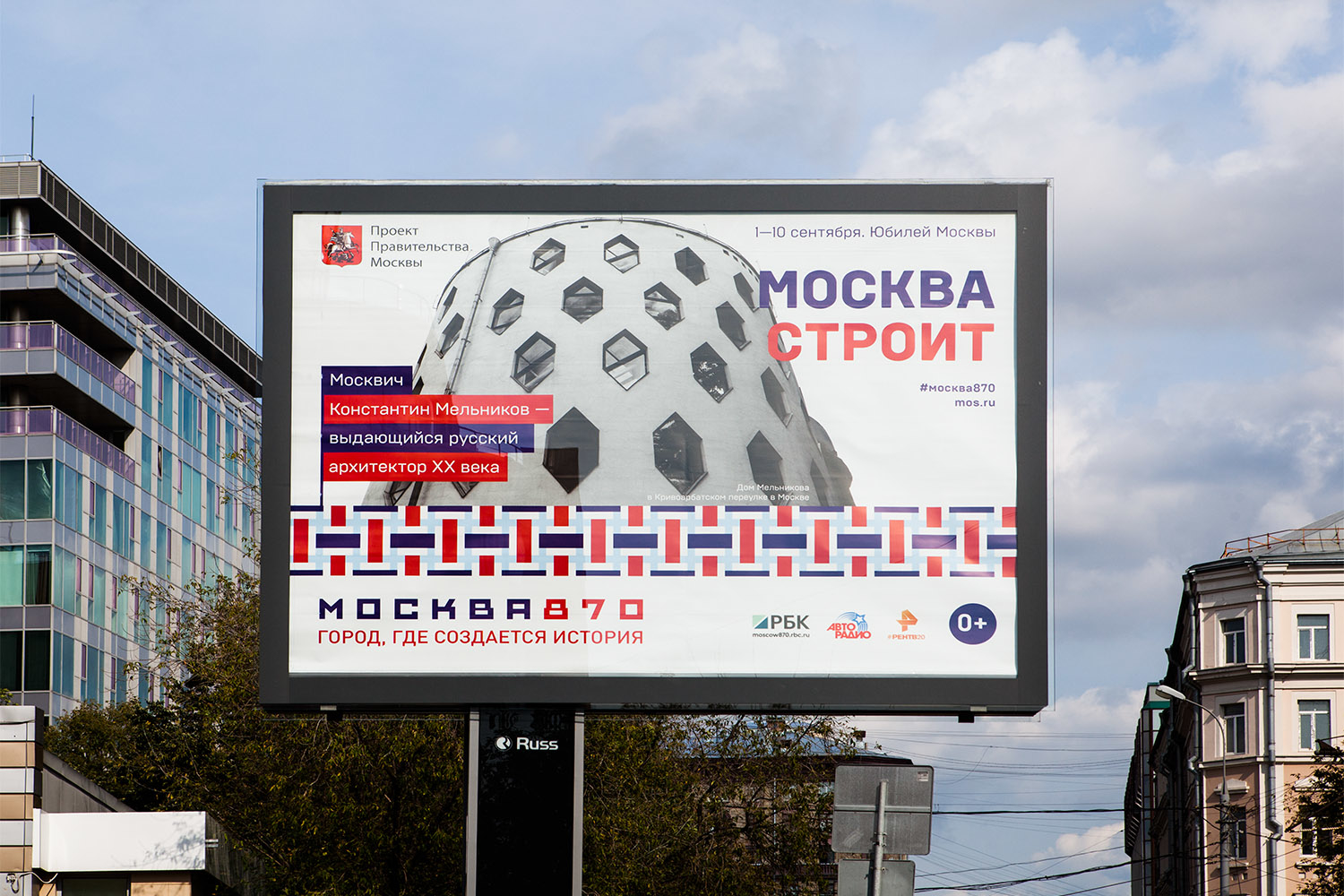
"Muscovite Konstantin Melnikov — an outstanding Russian architect of the twentieth century." | September 2017
Another poster that is part of the “Moscow Builds” theme features a portrait of Konstantin Melnikov, proclaiming “Muscovite Konstantin Melnikov — an outstanding Russian architect of the twentieth century.”8 Melnikov indeed left a distinct mark on Moscow, his buildings being some of the most well-known avant-garde monuments. But again there is a clear contradiction in professing that Melnikov is an outstanding architect, and taking a look at the fate of his buildings. The Svoboda, Burevestnik, and Frunze clubs have been extensively reconstructed. The concept of authenticity in restoration work not properly understood, such heavy-handed approaches cause irreversible damage. In the Russian context, the word “restoration” is used loosely, as is the case with the Rusakov Workers’ Club. It was reopened in 2015 with much fanfare since not every day an avant-garde monument is given a second chance at life. Even Moscow Mayor Sergei Sobyanin attended the opening, remarking that “This is a unique monument that has not only been restored, but also adapted for the needs of a theater outfitted with the most modern equipment.”9 Prior to the beginning of renovation work in 2012, the building was in poor condition and had even been twice included on the World Monuments Watch list of the world’s most endangered monuments as far back as 1998 and 2000. Officially a project for the “reconstruction, restoration, and adaptation” of the building to be used as a theater, such wording generally means that works will lean toward major reconstruction, rather than careful restoration. The Kauchuk Club likewise had never been restored prior to 2011, and the restoration has yet to be completed. In the meantime, the Novosukharevskiy Market Office, and Intourist and Gosplan garages, are all in poor condition with no plans for restoration in the foreseeable future. Melnikov’s one-off clubs and garages are either so heavily reconstructed that they are now pseudo-replicas of the architect’s original designs, or are still in need of investment and major repairs. The exception is Mossovet Truck Garage that has fared relatively well in comparison with Melnikov’s other garages; the building might house a museum in the future, though this is still at a concept stage. It is a sigh of relief that Melnikov’s architectural legacy still remains intact in some form in Moscow’s notoriously ever-changing cityscape. At the same time, the City Day posters and billboards, which on the one hand affirm Konstantin Melnikov as an exceptional architect, while a positive public endorsement of his architectural achievements, are on the other hand misleading if you consider the physical state of his buildings.
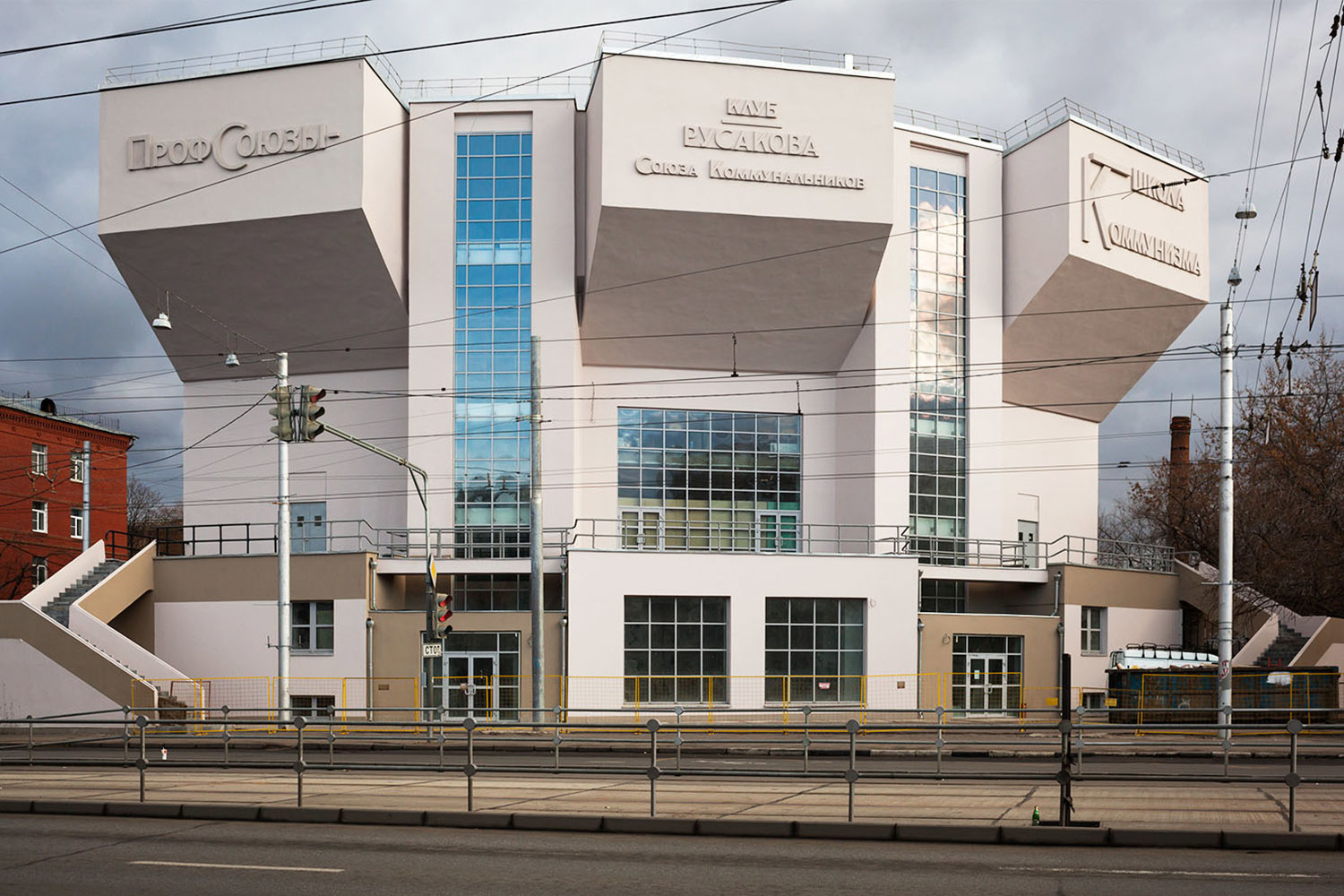
Rusakov Workers' Club | November 2014
Melnikov’s architectural heritage is indeed recognized as important — in concept — all of his buildings in Moscow are monuments of regional importance, the second highest monument status. The Melnikov House was even upgraded to the highest federal status as recently as 2015, becoming only the second early Soviet monument to enjoy such a status in Moscow, the other being Lenin’s mausoleum. Even if monument status does not provide guaranteed protection from demolition or damaging reconstruction work, it does symbolically convey the standing of avant-garde architecture among other architectural monuments. And for the city that contributed such an original and influential style, internationally recognized and revered, having so few buildings in Moscow with a federal status confirms the continued denial of the avant-garde. It should be noted that some progress has been made in listing more of Moscow’s avant-garde monuments, though even this process can be quite convoluted. The Ogonyok Printing Plant was rediscovered in 2007 when it was slated for demolition to make room for the construction of a luxury residential complex. At the time, the building was abandoned and rundown; however, it came to light that it was designed by none other than one of avant-garde’s key figures, El Lissitzky, previously only known for his designs on paper. As Lissitzky’s only implemented architectural design, Ogonyok was given monument status in 2008. Just a couple of months later, a suspicious fire broke out on the roof (a common occurrence to render buildings irreparable and speed up demolition); arson was suspected. Despite the attempts to remove Ogonyok’s recently acquired heritage status, the status held and ruled out the planned demolition. Nevertheless, the high-rise luxury residential complex was squeezed into the immediate vicinity, towering over Lissitzky’s “horizontal skyscraper” — the outline of this famous design can be seen in the plan of the printing plant.10 And though Ogonyok was upgraded to a regional monument in 2012, the building was gutted and completely reconstructed to adapt it for unspecified administrative functions. “This is a real masterpiece,” said Alexander Kibovskiy, head of the Department of Culture, of Ogonyok after it received its well-deserved status. “This building will be adapted into a hotel complex, it will be restored, which will give this building a second life.”11 Though Kibovskiy indicated Ogonyok would become a hotel, don’t get your hopes up to stay there. Ogonyok was found, recognized as a monument, and in effect lost during the renovation work. As such cases show, giving praise and assigning “protected by the government” plaques do not translate into proper preservation of the existing monuments.
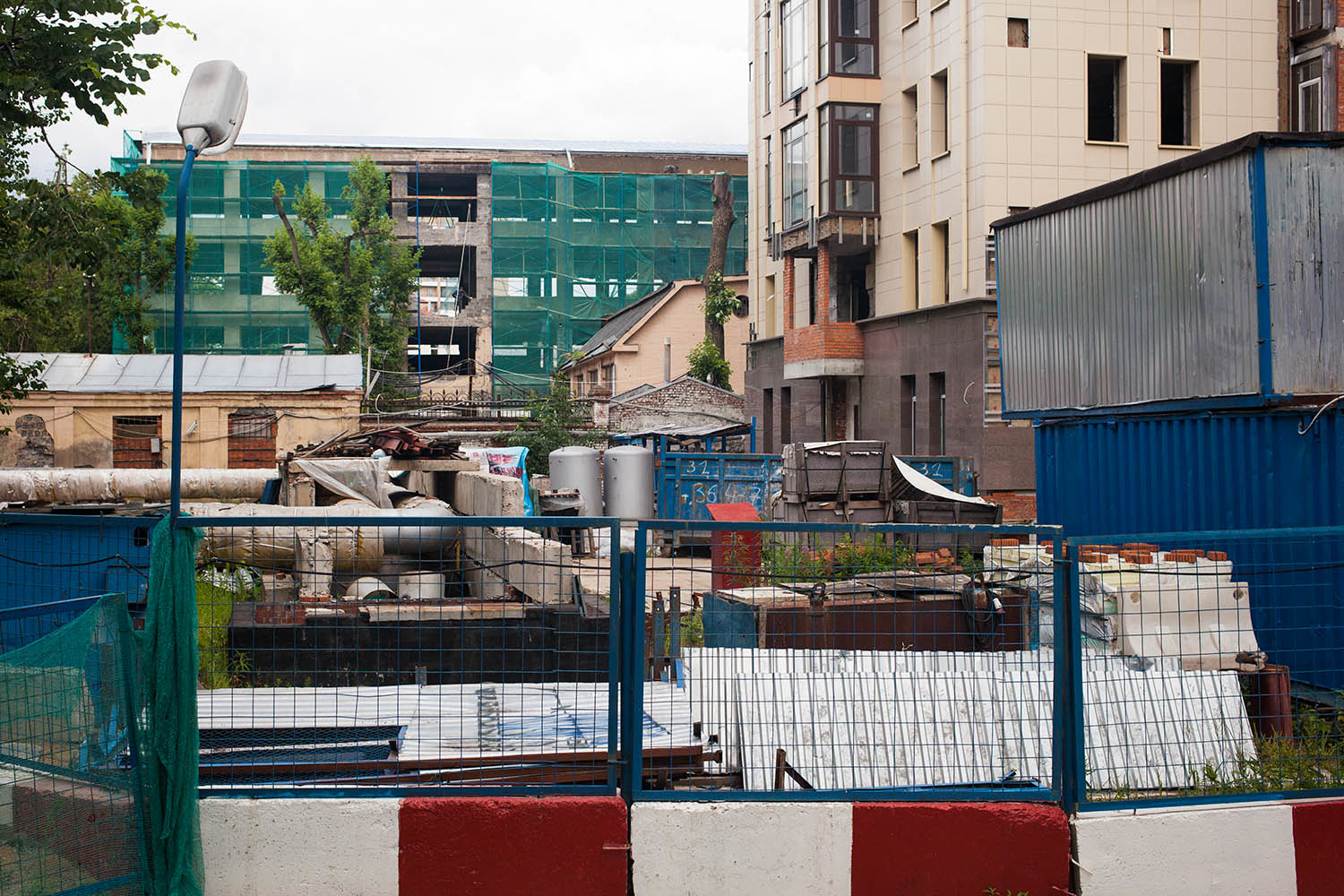
Ogonyok Printing Plant under reconstruction (left) & Lumiere luxury residential complex under construction (right) | June 2013
The Melnikov House, one of the most iconic architect’s homes in the world, has witnessed difficulties at every turn — from a botched restoration in the 1990s, to legal issues that continue to this day. The divided ownership of the house, already a long-standing problem, came to the forefront in 2014. The Shchusev State Museum of Architecture, managing only half of the house (the other half split between Melnikov’s granddaughters and the state), grew impatient and took matters into its own hands before the ownership issues could be resolved in court. The controversial methods employed by the Shchusev Museum in carrying out this forced museumification caused a scandal in Moscow’s architectural community, yet nevertheless in December 2014, only 3 short months later, the Melnikov House was hurriedly opened to the public as the Melnikovs’ Museum, a branch of the Shchusev Museum. The Ministry of Culture ignored numerous requests to intervene and mediate the legal, and moral, issues surrounding the legendary house.12 The Shchusev Museum assumed unilateral control over the fate of the house, despite the unsettled legal issues over the house and Melnikov’s archives, which continue to this day.
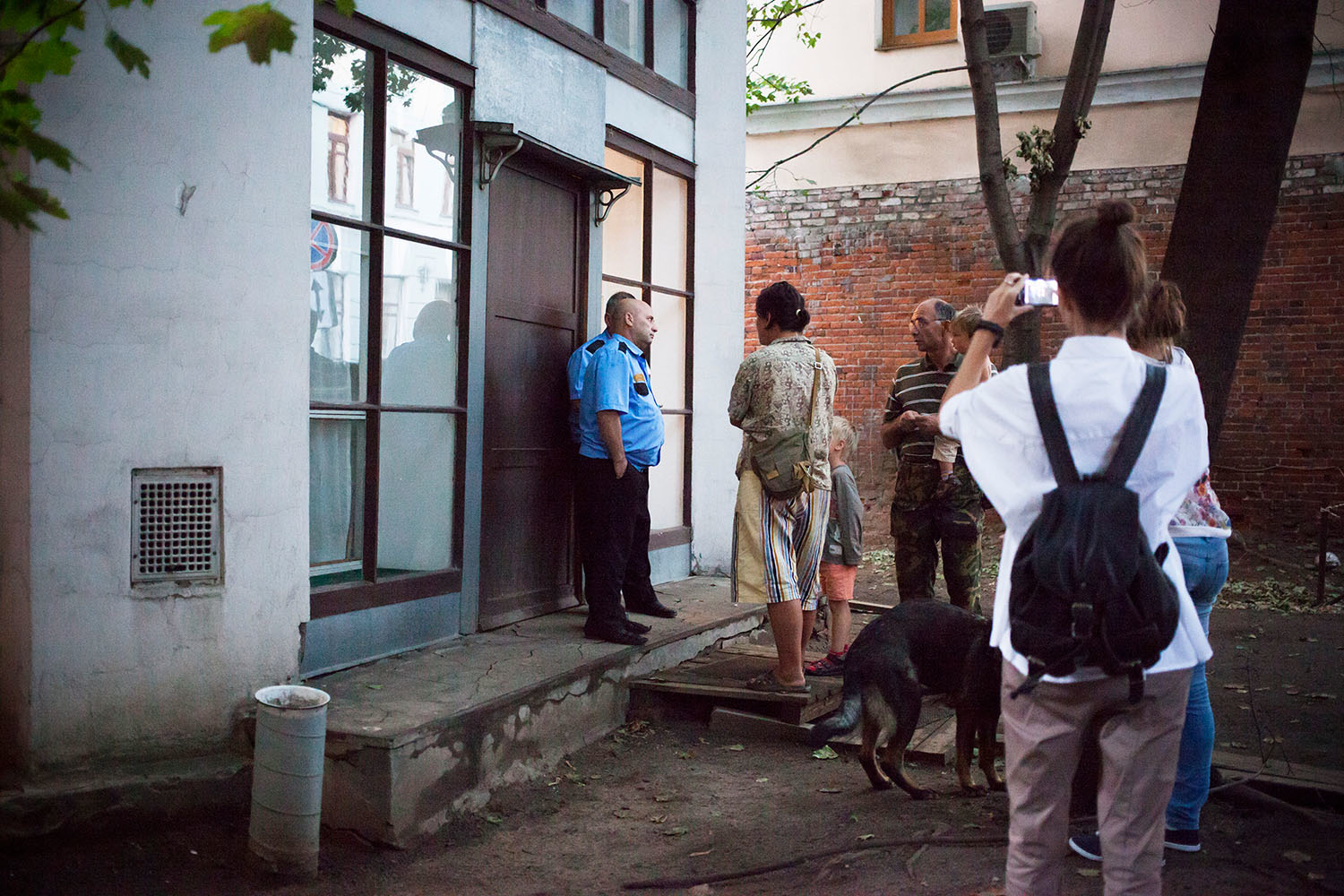
Shchusev Museum initiates forced museumfication of the Melnikov House | August 13, 2014
The models of architectural landmarks and iconic buildings dotting Tverskaya Street for the City Day festivities created a miniature portrait of Moscow’s representative architectural heritage, and the Melnikov House was among them. The Melnikov House also made an appearance in the form of coffee stands, its roundness an ideal shape for setting up a street cafe. Muscovites lined up to buy coffee, knowingly or not, from a replica of a building that despite all of its architectural merits recognized internationally, has had to fight for its existence in Moscow. This is the house that the World Monuments Fund included in its 2006 Watch list of most endangered buildings; the decision was based on four man-made threats: development pressures, inappropriate prior conservation, lack of financial resources, and lack of public awareness.13 Besides the particular uses during the City Day, the likeness of the Melnikov House can be found as a mug, on postcards and notebooks, in jewelry designs, and in an assortment of various souvenirs — its distinctive cylinders and hexagon windows readily commodified. The fact that the Melnikov House is featured on Russian-produced merchandise and was included in celebrating Moscow’s 870th anniversary, is a sign that avant-garde architecture can finally, in some aspects, be regarded as “cool.” It is of course only partial acknowledgement, as concrete measures to preserve the actual building have yet to be carried out and will be funded not by the federal budget or a Russian organization but by a Keeping it Modern grant from the Los Angeles-based Getty Foundation to develop a conservation plan for the house.14
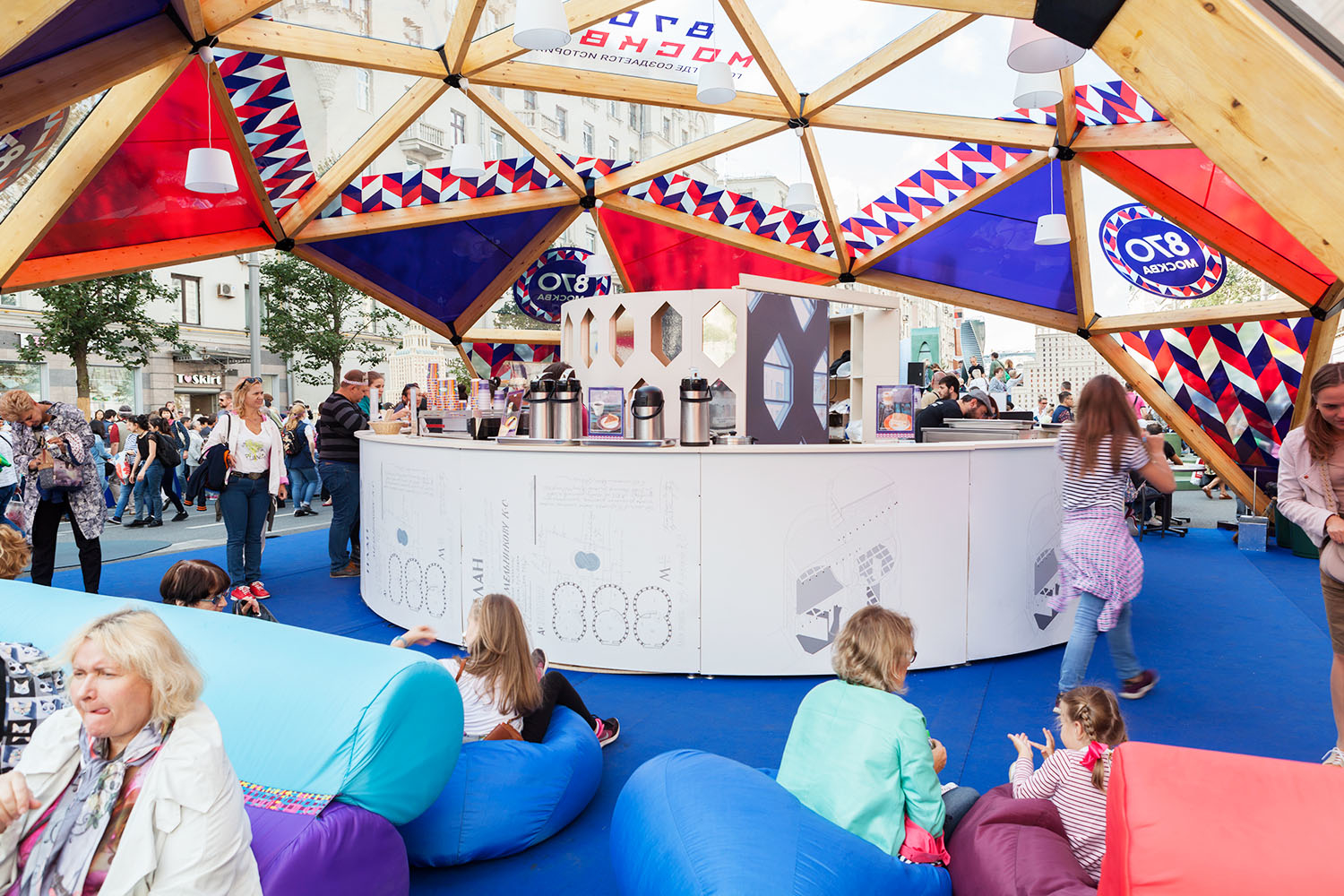
Melnikov House cafe on Tverskaya Street during City Day celebrations | September 2017
The third building chosen to represent the avant-garde on Tverskaya Street as an art object was another work by Konstantin Melnikov — the Bakhmetevsky bus garage. Also in the category of heavily reconstructed, the garage nevertheless is an example of successfully repurposing an avant-garde building for modern use, essential for the survival of historic buildings. Post-reconstruction, it first housed the Garage Center for Contemporary Culture and currently, the Jewish Museum and Tolerance Center. The garage is in pristine condition today, it occupies the same physical space as the original building but has lost claim to being an authentic monument. And paradoxically, the Bakhmetevsky garage was chosen instead of the Narkomfin building — “recognized all over the world as the finest, most elegant and important example for the epoch-making architecture of Russian Constructivism”15 — to join the Shukhov Tower and Melnikov House as the prime symbols of the avant-garde. Perhaps it was the present-day embarrassingly deplorable condition of the legendary Narkomfin building, after years of neglect, that led the decision-makers to favor the like-new copy of the Bakhmetevsky garage to parade on the City Day? Like all other architectural monuments, constructivist buildings do look much better when properly maintained, yet even the most famous of them are willfully neglected.
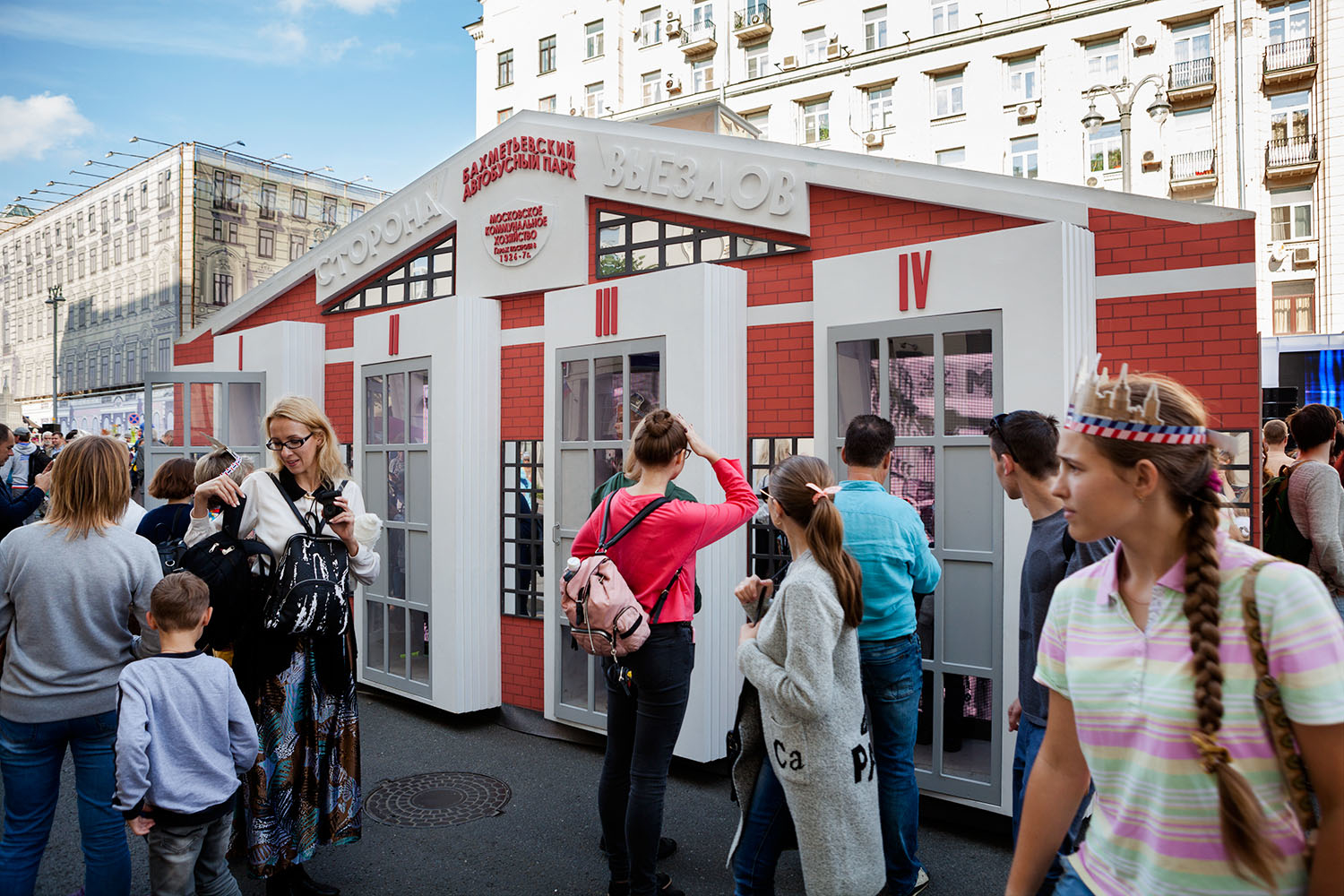
Bakhmetevsky bus garage art object on Tverskaya Street during City Day celebrations | September 2017
Moisei Ginzburg’s and Ignatiy Milinis’ Narkomfin residential experiment can be found in every book on modern architecture. Not even once repaired since its construction in 1930, various efforts have been made to restore the complex since the 1980s, all unsuccessful. Included in the World Monuments Watch three times16, Narkomfin slid further into disrepair without any action on the part of Moscow authorities. Next to the new Novinsky Passage shopping mall, Narkomfin indeed looked more and more like a ruin.
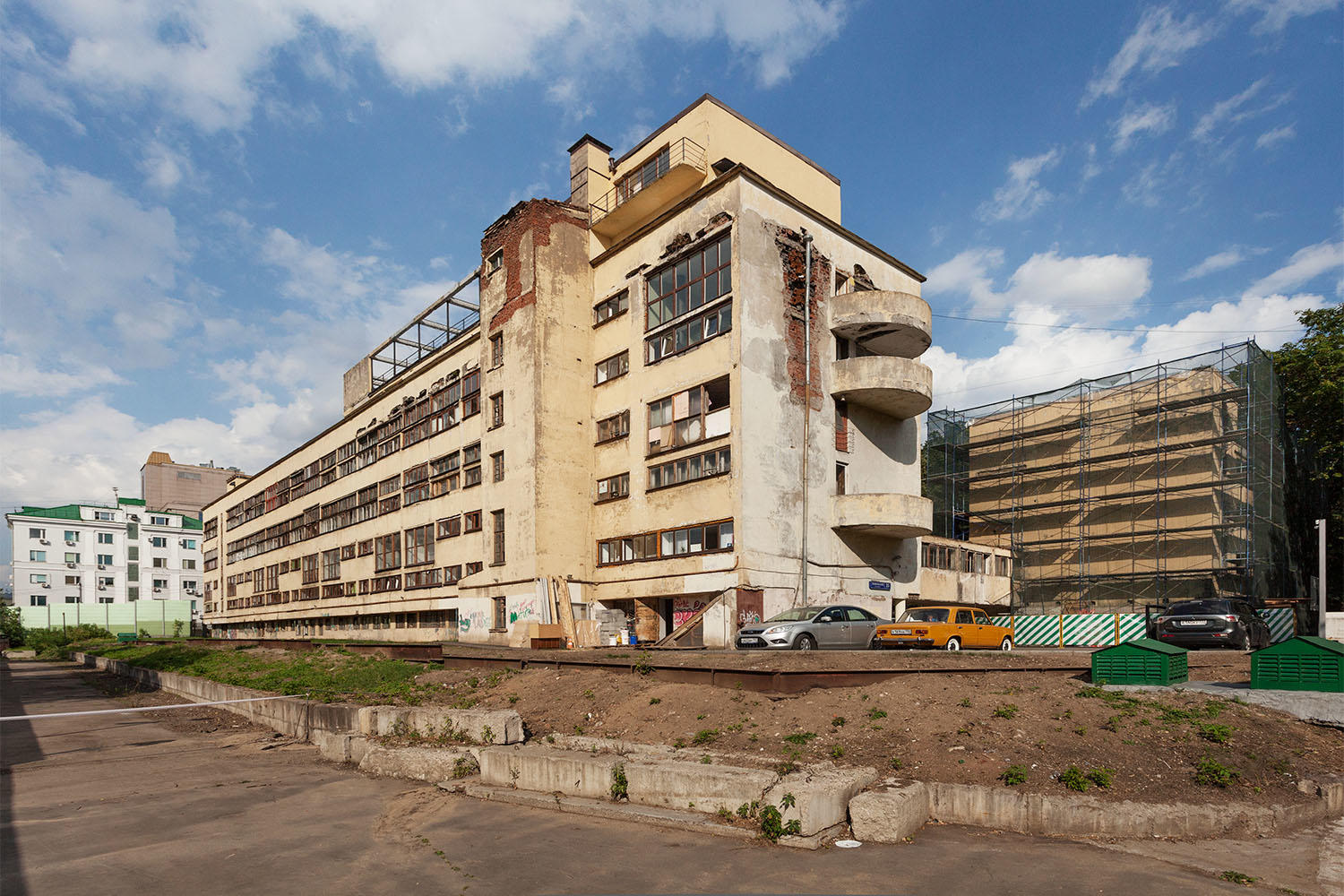
The beginning of restoration works on Narkomfin | August 2017
One of the main problems with constructivist architecture is the false notion that the majority of the buildings from the 1920s were made of poor quality materials and are either impossible or too expensive to restore. Marat Khusnullin, Moscow Deputy Mayor for Construction and Urban Development, commented in 2016 on constructivist residential buildings, “We are for constructivism, although personally I think these buildings should be left as monuments of what should not be built.”17 Unfortunately, personal opinion from a high-level government official has negative consequences for avant-garde heritage. In 2014 the Moscow Department of Cultural Heritage was slow to react to the numerous illegal repairs being haphazardly carried out throughout Narkomfin, regardless of its monument status and fame as a masterpiece of constructivist architecture. Original elements were either damaged or covered up in a wave of cosmetic repairs, further complicating future restoration work. Narkomfin’s fate changed when ownership of the building was finally consolidated in 2016 (previously split between the city of Moscow, privately owned apartments, and a succession of developer companies) and provided the opportunity for a large-scale restoration. Alexey Ginzburg, grandson of Moisei Ginzburg, was invited to develop the project for the restoration and adaptation of Narkomfin, which will return the building to its original design and function as a residential complex. Restoration work began in June 2017, and as a show of government support, Moscow Mayor Sergei Sobyanin visited Narkomfin remarking, “There was a real danger of completely losing this monument. And so we welcome the fact that the building now has a consolidated owner who has begun restoration work. The volume of work to be done is very large. But we hope that as a result, Narkomfin will gain a second life that will be even better than the first.”18 The successful revival of Narkomfin, from both a diligent scientific restoration and business point of view, would indeed be a welcome precedent of the capitalization of avant-garde heritage in Moscow.
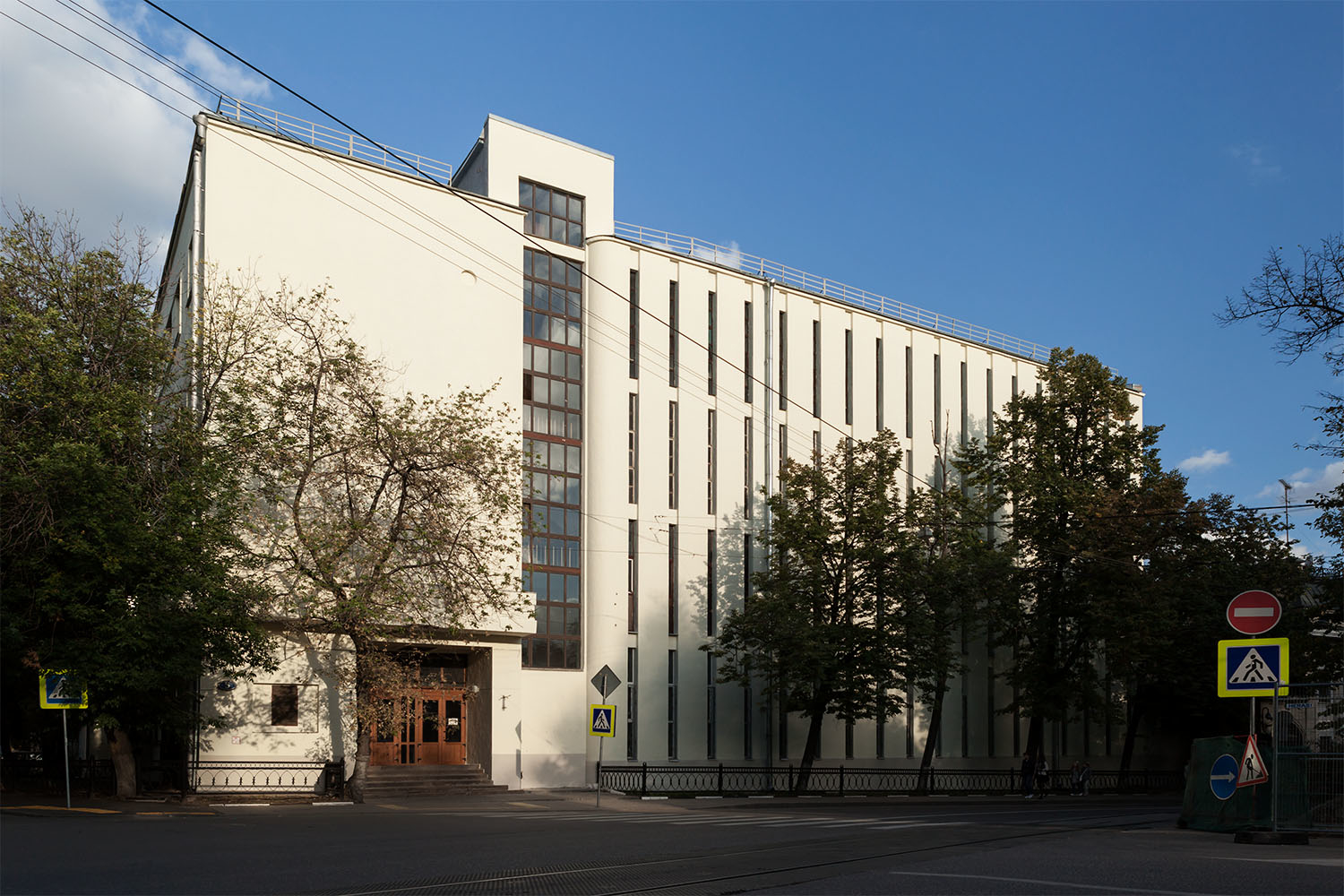
Tagansky automated telephone exchange | September 2012
Even if the building is in good condition, there is a bias against the minimalist aesthetics of constructivist architecture. The Tagansky automated telephone exchange, built in 1929 by architect Vasily Martinovich, was a vivid example of avant-garde era industrial architecture. Both the facade with its distinctive narrow vertical windows (so designed due to the technical equipment housed inside) and the interior structure were in good condition when the decision was made to demolish the building and build in its place a luxury apartment complex. The reasons given for the demolition of the telephone station were many, from the alleged impossibility of adapting it to modern use, to its dissonance with the surrounding classical buildings.19 The appearance of the building, mainly the lack of ornamentation — a key characteristic of the constructivist style — became a main argument against preserving it, as expressed by the Department of Cultural Heritage: "The facades emphasize the strictly utilitarian function of the building … the windows are slits without any decorative elements. Thus, the building does not have any valuable decorative and architectural or artistic elements."20 The demolition of this previously little-known constructivist building became the surprise scandal of 2016, causing a heated debate about the perception of constructivist architecture in Moscow. The city’s leading architects and architecture specialists sent an open letter to Moscow Mayor Sergei Sobyanin, in which they disagreed with the assessment by the Department of Cultural Heritage that stated the telephone station lacked the historic and architectural merits to receive monument status.21 An online petition collected over 35,000 signatures against the demolition22 — quite a feat considering the telephone station only recently came to the attention of the general public. Despite the public outcry, the building was demolished. Echoing the Department of Cultural Heritage’s conclusion that the austere constructivist building visually did not fit in among the surrounding 18th and 19th century manors, the developer commissioned Mezonproekt architectural studio to design a building that would be stylistically harmonious with the historic neighborhood. Ilya Mashkov, head of Mezonproekt, explained how this harmony would be achieved in the new building: “We understand the ‘style of this place’ as the features that are inherent in pre-revolutionary buildings, and this is primarily the art nouveau style, which is distinguished by richly detailed facades with a variety of elements that are perceived as visually pleasing. This style not only supports the spirit of ‘old Moscow’, but also will be of interest to tourists looking at surrounding buildings.”23
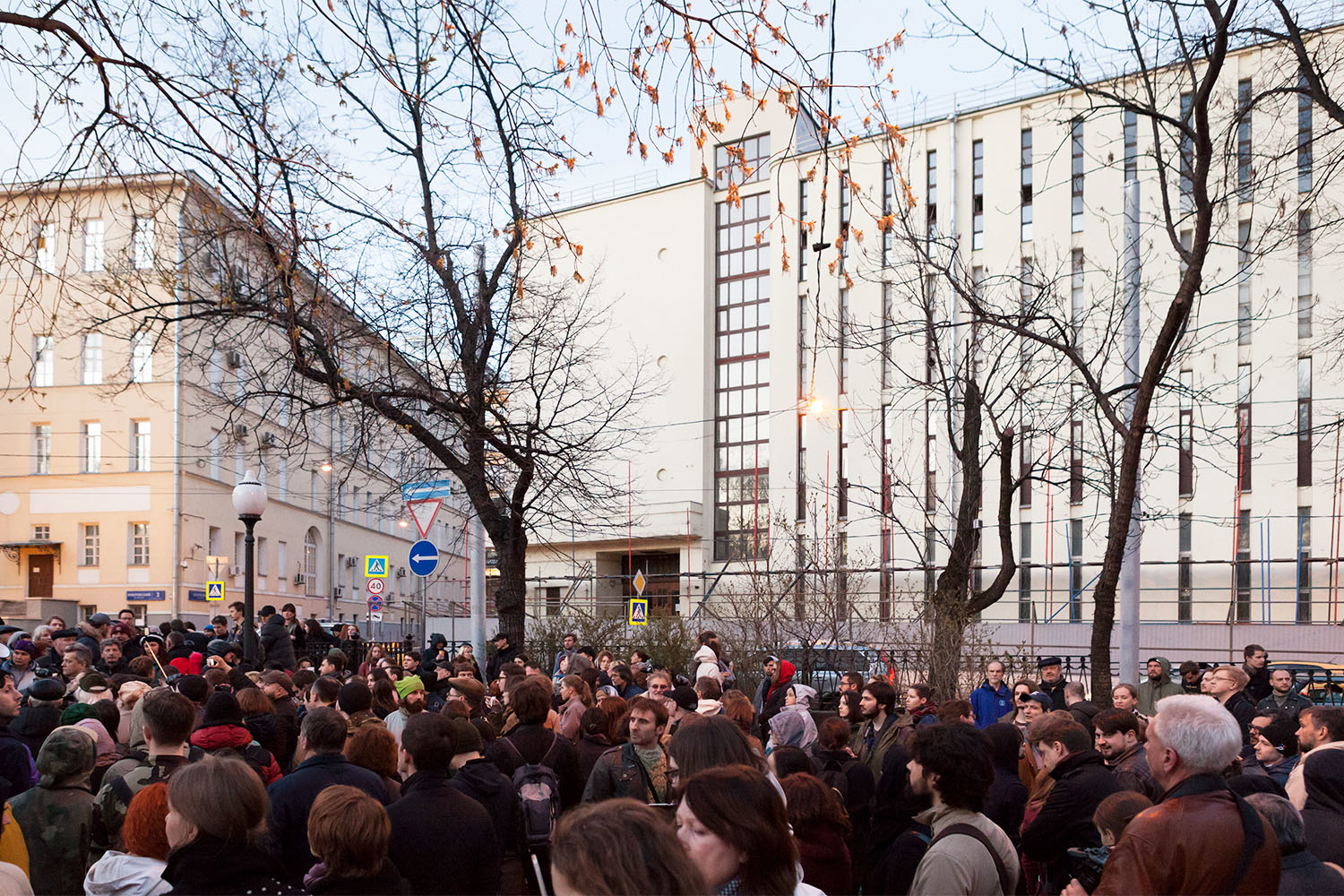
Rally against the demolition of the Taganksy automated telephone exchange | April 2016
With such an understanding of what makes up ‘old Moscow’ and what is perceived as ‘beautiful’ architecture being all too common among developers and city officials, in the city where history is made, it’s not hard to understand why erecting historically-styled modern edifices is preferred over preserving the existing authentic historical buildings. Constructivist architecture is particularly vulnerable as it continues to be defamed for its aesthetics. The repression of constructivist architecture began in the 1930s when it was considered to be formal, bourgeois, and even “ideologically imposed foreign architecture.”24 In 2006 Anke Zalivako stated that “because of its simple facades Constructivism still remains stigmatized as ‘non-Russian’ in the taste of most citizens.”25 A decade later, it still seems to be the case, and the preference for classical, ornate architecture continues. There are numerous examples of constructivist buildings being demolished to be replaced by luxury apartment complexes executed in a pompous, neoclassical style.26
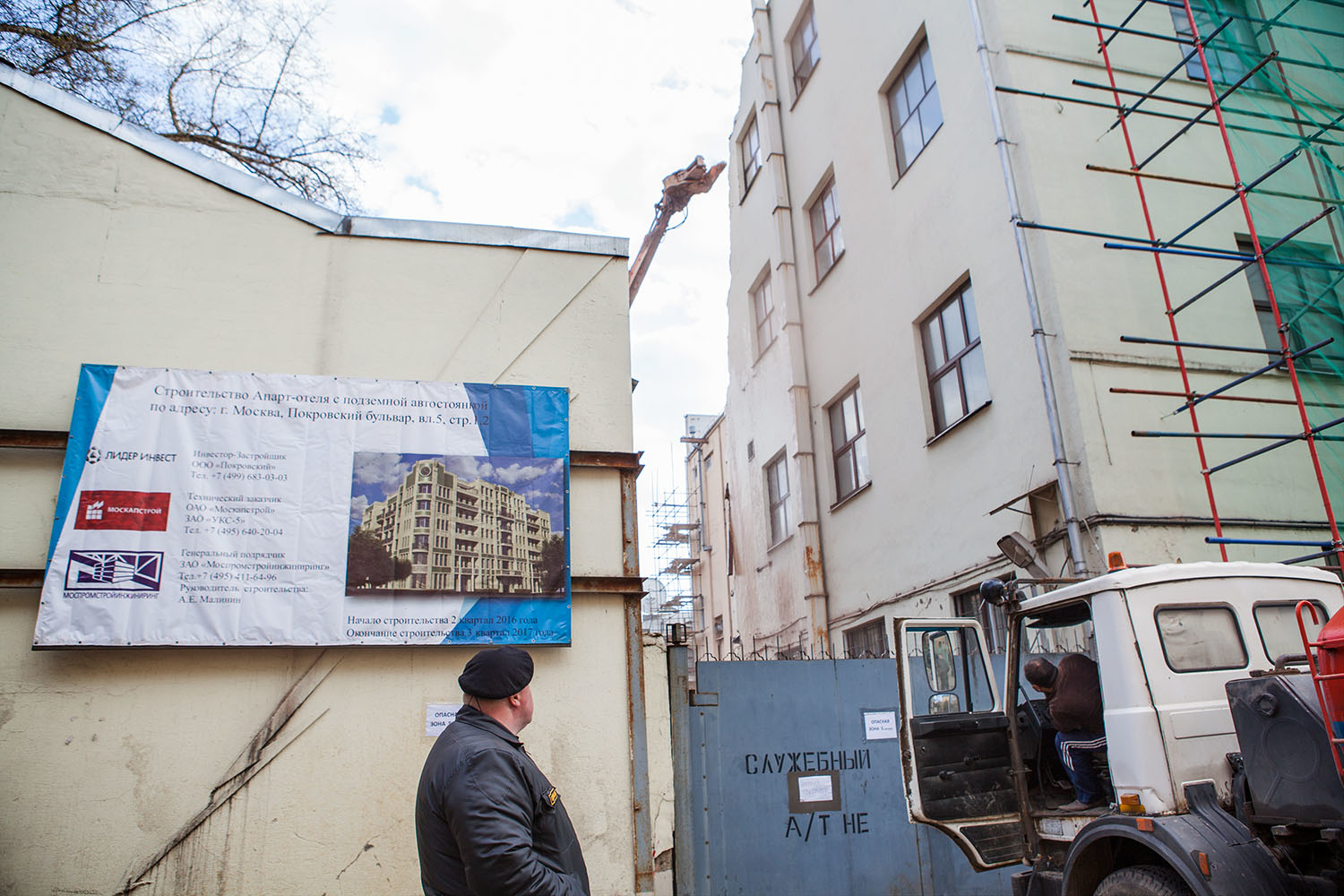
Demolition of the "utilitarian" Tagansky telephone station to make way for a historicist style luxury apartment building | April 2016
The centenary of the Russian Revolution has put a spotlight on the revolutionary art of the twenties with many international exhibitions, conferences, and publications dedicated to it, whereas avant-garde architecture continues to be an undercapitalized resource in Russia. Visitors to Moscow are often surprised to see a freshly renovated downtown while many avant-garde era buildings are in a ruinous condition or inaccessible to tourists despite their world-fame, the Shukhov Tower being a perfect example — both neglected and hypocritically celebrated at the same time. Still, choosing the avant-garde as the brand for Moscow’s anniversary is a clear indicator that various efforts to popularize and rehabilitate this heritage have reached top city officials. The significance of the Russian avant-garde heritage for the identity of Moscow and for potential tourism was previously presented back in 2011 at the Moscow Urban Forum27, and now in 2017 this was effectively realized in the City Day branding. The Russian resource website for the FIFA world cup in 2018 features a special section introducing future football visitors to “Constructivism. Legacy of the Soviet Era,” and goes as far as positioning constructivism as “the country’s brand identity along with ballet, hockey and space exploration.”28 The number of lectures, special events and tours on the avant-garde has steadily increased over the years, a key way to introduce Muscovites to the heritage of the city in which they live. Guidebooks, maps, and websites provide information on avant-garde buildings, while souvenirs show off their recognizable designs. Awareness and popularity of the avant-garde legacy are unequivocally moving in a positive direction while admittedly, appreciation of avant-garde architectural heritage in Russia is still for the most part superficial — promoting the idea of the avant-garde while neglecting the actual buildings: there’s a lengthy list of buildings under threat, and a much shorter list of completed restorations. But now that Russia has warmed up to the idea of the constructivist brand, and Moscow is looking back at its rich history as it moves forward with an ambitious revival program of its urban fabric — the time is ripe to polish its unique cultural arsenal of constructivist gems.
- - - - - - - - - - - - - - - - - - - - - - - - - - - - - - - - - - - - - - - - - - - - - - - - - - - - - - - - - - - - -

